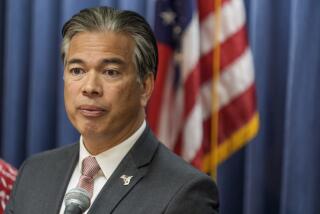Secession Will Put LAFCO in the Hot Seat
- Share via
It is an innocuous state agency that typically goes about adjusting the boundaries of water and sanitation districts in Los Angeles County with little controversy or scrutiny.
But if San Fernando Valley secessionists have their way, the Local Agency Formation Commission, or LAFCO, will be in the spotlight as never before, if and when it rules on the breakup of the second-largest city in the nation.
LAFCO is the only government body with the authority to judge a Valley secession proposal--and its decision can only be overturned by a court of law.
“LAFCO has never had a challenge of this magnitude in recent history,” said Los Angeles County Supervisor Zev Yaroslavsky, one of nine appointed LAFCO board members.
Although such a decision is still years away--if it ever occurs at all--the agency’s staff and board are already cringing at the thought of ruling on a proposal that could create the nation’s sixth-largest city and in the process shrink Los Angeles by one-third.
“LAFCO will be criticized by all sides,” said Executive Director Larry Calemine, a former developer and civil engineer. “No one ever expected anything this big to come down the pike.”
Calemine works for a governing board that includes a florist, a veterinarian, a retired municipal judge and several politicians, all appointed by the Board of Supervisors, the City Council, special districts and local cities.
The agency, which works in two small offices in the county Hall of Administration, has a staff of only three full-time employees and a budget of about $400,000.
So it is no surprise that the agency is already fretting about how it will fund the studies needed to evaluate the massive, unprecedented breakaway proposal.
“We are not going to be able to do this job with the staff that we have,” said Chairman Thomas E. Jackson, a Huntington Park councilman who owns a flower shop in that city. “Someone is going to have to come up with the bucks.”
Calemine has estimated the costs for studies needed to determine how to divide public facilities, city staffs and bond debts, among other issues, at more than $1 million.
State law allows LAFCO to impose the cost of the studies on the petitioners--in this case, Valley secessionists. But Yaroslavsky opposes such a move, saying it’s the role of government to pay for such costs.
“We don’t ask people who run for office to bear the cost of the election,” he said. “That is a government responsibility.”
Jeff Brain, co-founder of Valley VOTE, a group formed to support a bill to facilitate Valley secession, also wants LAFCO to fund the study because he fears critics may question the integrity of the study if it is funded by Valley VOTE.
The talk of secession gained steam last year when then-Assemblywoman Paula Boland, a Granada Hills Republican, pushed a bill to remove the City Council’s power to veto a secession drive. She argued that the council’s veto power robbed Valley voters of the right to decide their own fate.
Boland’s bill died in committee but was revived this year by Assemblymen Tom McClintock (R-Northridge) and Bob Hertzberg (D-Sherman Oaks). Gov. Pete Wilson signed the Hertzberg-McClintock bill last month, reigniting the hopes of Valley secessionists.
But breaking up is always hard to do.
Before LAFCO can evaluate the feasibility of a Valley secession, activists must collect the signatures of 20% of the registered voters in the Valley--or about 100,000 signatures.
If they succeed, secession advocates would submit the petition to LAFCO, requiring the agency to launch a study that for a successful breakaway must find a Valley secession to be “revenue neutral.” In other words, the breakaway cannot cost either the Valley or the rest of Los Angeles any extra money or make a profit for either.
The requirement that a secession must be revenue neutral was included in state law in 1992 by financially strapped California counties worried that breakaway efforts would be motivated by monetary considerations.
Since the law went into effect, only two new cities have been formed--none in Southern California.
If the study concludes a Valley secession would be revenue neutral, the board can decide to endorse the secession application and send it to the County Board of Supervisors, which would schedule a citywide vote on the matter.
State law requires secession support by a majority of voters citywide, including the Valley, before a breakaway can be completed.
Already, LAFCO staff and board members are bracing for what they expect will be a bitter, litigious squabble that could drag on for years.
“It’s going to be controversial but name me something that isn’t,” said LAFCO Commissioner Larry Connelly, a veterinarian and director of the Littlerock Creek Irrigation District in the Antelope Valley.
LAFCOs were created--one in each county--by the state Legislature in 1963 to give local officials the power to create their own boundaries for cities, school districts, water districts and other jurisdictions.
Like most other LAFCOs, the agency in Los Angeles operates nearly anonymously on matters considered so dull that meetings are rarely attended by anyone other than bureaucrats and applicants who have business before the panel.
“It’s pretty mundane stuff normally,” Yaroslavsky said.
LAFCO, however, drew some attention two years ago when the board picked Calemine--who had been an alternate board member--as its executive director. County counsel had issued an opinion that Calemine was ineligible for the $75,000-a-year post because he had served on the panel during the job search.
But Calemine argued he had dismissed himself from LAFCO meetings when discussion of the job arose. Critics also claimed that Calemine, through his work as a developer, had too many ties to real estate interests that might have business before the board.
The panel dismissed such criticism and decided to appoint Calemine, in part because he and another LAFCO board member were the only candidates for the job.
Calemine also dismisses criticism about his ties to developers, saying no one has since questioned his integrity.
It is still too early to predict how LAFCO will rule on the Valley secession bid, and LAFCO’s track record does not offer a clear pattern on which to base a guess.
For instance, LAFCO approved the incorporation of West Hollywood in 1984, Santa Clarita in 1987, Calabasas in 1989 and Malibu in 1991. But those efforts took years to complete and required an iron-willed persistence from cityhood advocates.
But in 1986, LAFCO rejected an effort to create the city of Marina del Rey from 804 acres of unincorporated land flanked on three sides by the city of Los Angeles and the fourth by the ocean.
LAFCO determined that the city of Marina del Rey would lose $2 million in its first year and that the incorporation drive was too heavily based on rent-control issues.
But secessionists may be optimistic knowing that some LAFCO and staff members have expressed sympathy for a Valley secession.
Calemine and Los Angeles Councilman Hal Bernson, a longtime member of the LAFCO board, were leaders in the Committee Investigating Valley Independent City/County, a group formed in the 1970s to study the possibility of withdrawing the Valley from the city and county.
Richard Close, president of the Sherman Oaks Homeowners Assn. and an alternate on the LAFCO board, is one of the most outspoken proponents of Valley secession and helped form Valley VOTE.
But all three reject suggestions that their past or current positions will prevent them from impartially judging the viability of the proposition.
“It’s OK to come in with certain points of view,” Close said. “If we are not allowed to vote, that is like saying a legislator with a view on the death penalty should not be allowed to vote on a bill having to do with the death penalty.”
Calemine said he can put his previous affiliations behind him while managing a study of Valley secession.
“I’m a professional,” he said. “I’m not biased.”
More to Read
Sign up for Essential California
The most important California stories and recommendations in your inbox every morning.
You may occasionally receive promotional content from the Los Angeles Times.











